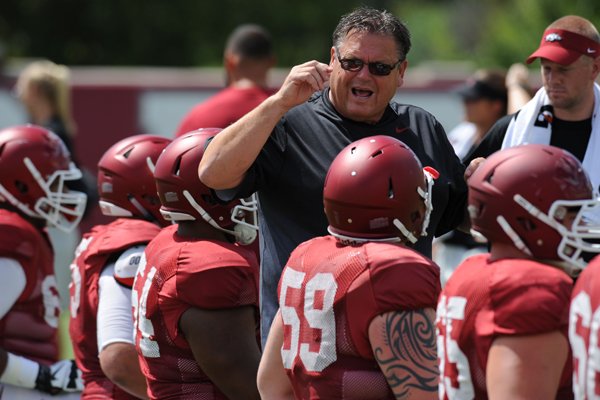FAYETTEVILLE — Arkansas coach Sam Pittman watched from the back porch of his new Fayetteville home on April 23 as two of his former offensive linemen from Georgia were selected in the first round of the NFL Draft.
The selections of Andrew Thomas fourth overall to the New York Giants and Isaiah Wilson 29th overall to the Tennessee Titans brought to seven the number of first-rounders who were coached by Pittman in college. Thomas and Wilson were both recruited by Pittman and played all three seasons with him as their offensive line coach at Georgia.
Pittman’s reputation as a recruiter and strong teaching coach was key in his hiring as Arkansas’ head coach last year. Pittman’s head coaching experience is limited to high schools and a junior college in the 1980s and 1990s, but he has been on staff at a number of high-level programs for the past quarter-century because of his ability to evaluate linemen in high school and coach them up in college.
Pittman’s longevity and success as an offensive line coach probably couldn’t have been predicted when he began his career. He was a running back and kicker in high school, and played defensive line in college at Pittsburg State.
In 1987, at the age of 25, he was hired as head coach of the high school in Princeton, Mo., a small town just south of the Iowa border. When he got the job he called two of the most trusted football coaches he knew: his dad and brother.
Pittman’s father, Don, was a football coach-turned-public schools administrator who coached him in a church league. His older brother Ron had played center in college at Southwestern Oklahoma State and coached the offensive line as a high school assistant in Oklahoma for a short time before beginning his own administrative career.
The Pittmans spent a week together in Princeton, a time during which Sam soaked up every bit of knowledge he could.
“My dad told me if I wanted to be a good coach, I needed to learn offensive line play,” Pittman said. “He brought my brother up, and I picked my brother’s brain.
“My brother basically taught me the fundamentals of coaching the offensive line.”
Their time together coincided with an offseason camp for Pittman’s new team.
“We got up there and just basically taught them how to block, what you needed to do,” Ron Pittman said.
“We went through some basic steps as far as hiking the ball and stepping at the same time. We tried to teach the other guys on the line that the guy that’s the quickest is easily the winner on this deal, to stay low and what we call fire out. Fire out, make contact and push those kids in the best way you can.”

Arkansas football coach Sam Pittman (left) is shown with his father Don (center) and brother Ron.
One of the drills the Pittmans taught that week they called the “Arkansas scramble block.” Ron Pittman said he believed it to be named for a drill the Razorbacks taught their undersized linemen in the 1960s and 1970s.
“If you could get between their legs and push them with your body, that was called a scramble block,” Ron Pittman said, “so those littler guys had to really get down there and take on those bigger guys.”
The thought was that you could teach offensive linemen to play the position like a defensive lineman — “to tackle without tackling,” as Sam Pittman put it — by generating force with your hips, like a defender would do when lunging to tackle.
“Blocking in those days, you couldn’t put your hands on people or they’d call you for holding,” Ron Pittman said. “You had to use your shoulder pads or your forearms.
“When you would fire out and hit somebody, you would throw your arms forward and that would give you a little bit of leverage to move them with your forearm. But you couldn’t grab them. It was hands off. We could not use our hands at all, so basically we had to make sure we got our heads and shoulders in front, basically like they teach tackling nowadays, only you had to have your arms folded and you couldn’t touch them with your hands.”
Sam Pittman said he has taken those early philosophies with him throughout his coaching career. He teaches his linemen to play with a down shoulder and to focus on the defender’s near leg and near shoulder, similar to the way tackling is taught.
“What I wanted to do, I didn’t want a stalemate,” he said. “I wanted to knock them [defensive linemen] back off the ball, and I needed a leverage shoulder and a leverage leg so I could knock them back off their hips. I just went with that philosophy that that brought power, so we started teaching it and I liked it, and to this day that’s how I coach offensive line.”
In his early days of speaking at coaching clinics, Pittman would battle some insecurity because he didn’t think anyone was teaching line play like he was.
“I was kind of embarrassed, like people were laughing at me about it,” he said. “It turned out to be a pretty good thing. We’ve had a lot of success wherever we’ve been on the O-line.
“The technique we’re using, a lot of coaches are using it around the country now.”
The seeds to that trend were planted in a small Missouri town more than three decades ago.
“Back then, it was just like, ‘What can I tell him to get started with?’” Ron Pittman said. “Get in a good stance and come off the ball.”

